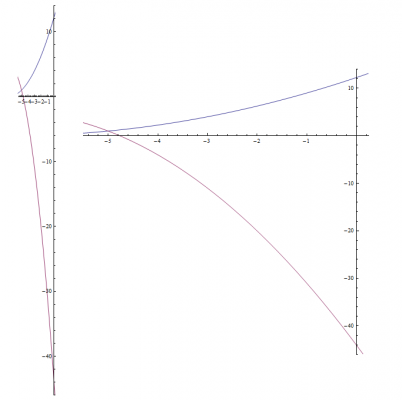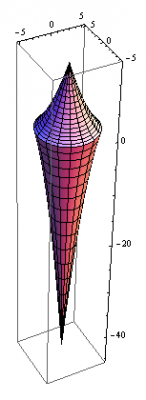-
Posts
719 -
Joined
-
Last visited
-
Days Won
2
Content Type
Profiles
Forums
Events
Everything posted by Daedalus
-
In Windows, you can open a command prompt (cmd.exe) and type "netstat -a" to see a complete list of all the connections to and from your computer. However, there are several programs that make connections. This is perfectly normal. You can type "netstat ?" to access the help for netstat. There are other options that might help you track down unwanted connections. Once you have an ip address you want to trace, type "tracert ip" and it will begin to trace through the hops that the connection went through. However, this information isn't really helpful for the average person. There are programs that will use tracert to trace the connections and display the hops on a map of the globe.
-
It has been a long time since I've posted one of my challenges. The reason is not because a lack of time. Instead, I am running out of problems that can be considered interesting or at least require some skill in solving mathematical puzzles. Sure, I could try to find something on the internet, but I don't want you to be able to simply look up the answer, and I want the problems to really make you think about possible solutions so that you discover something new for yourself, which is way more rewarding than having someone teach you math. For those of you that have never seen them, here are the links to my previous challenges (the first challenge is my favorite, but I also really like the second and fourth challenge too): Daedalus' First Challenge Daedalus' Second Challenge Daedalus' Third Challenge Daedalus' Fourth Challenge Daedalus' Fifth Challenge My sixth challenge is based on the Collatz conjecture. Wikipedia provides a decent explanation of the problem: The problem is also defined by Wolfram as: Although I haven't proved the conjecture, I have discovered that I can predict the odd numbers that reduce to one given the count of odd numbers contained within their Hailstone sequence. For instance, the number 3 has three odd numbers in its Hailstone sequence: {3, 10, 5, 16, 8, 4, 2, 1}. However, I cannot easily predict the count of odd numbers contained within the Hailstone sequence of a given odd number. The challenge is to provide the equation(s) for the odd numbers that reduce to one given a count of two odd numbers in their Hailstone sequence as well as a count of three odd numbers in their Hailstone sequence. As usual, I will give ample time to find the solution and give reputation to the one who solves it first.
-
The single biggest problem in communication is the illusion that it has taken place. - George Bernard Shaw
-
Really? You thought it was weird. This is an open forum where anyone can participate. I simply asked you what was weird and provided you with my explanation. If you didn't want further clarification, then you could've taken a very different aproach to your replies, but you didn't.
-
This is how the conversation went... Here, your statements suggest that you do not understand why profile views are greater than visitors. You make no mention of your method of tracking. So I am left with reiterating what iNow said: Although I tried to answer your question given the limited information you provided, I even included a smiley face to indicate I was exaggerating and not actually being serious. Again, you do not mention anything regarding your actual thought process and how you've been tracking visitors. So we are left in the dark. I'm not cherry picking these quotes. Here, you accuse me of not understanding without sharing your thought process, and it's all downhill from there. I'm not insulting you or directing derogatory statements towards you. I only gave you 1 negative rep point for your attitude and tone of voice. The rest you earned yourself. It is not I or anyone else who is being average minded or obscure in trying to answer your question. You can only have your questions answered if you provide enough information. This will be the last time I post regarding this as it has derailed and hijacked this thread!
-
What's even cooler is that the gamma function, which is the same integral with the lower limit set to zero and the upper limit set to infinity, actually produces the same sequence as factorials except it is defined over the reals.
-
Well, that isn't clear at all. You left some ambiguity on how you were tracking the site, which lead to the confusion concerning your situation. Yes, I did make some assumptions as a result. However, none of them were insulting or meant as a derogatory statement regarding your comprehension. Perhaps, you should be more clear in your meaning as to avoid future conflict.
-
Let's be civil. No need to make assumptions regarding my level of comprehension. I simply asked you a question about where you are seeing a list of the 27 people who visited your page last. I guess you are manually creating a list as new people visit your profile because I can't find a setting that allows me to view the last 27 people who viewed my profile. I assumed that you read the entire thread and realized that when non-members view your profile that they don't show up in the visitor list, but do count towards your profile views.
-
Where are you seeing a list of 27 people? This is getting off topic, but I can only show the last 5 visits to my profile as determined in my settings. I created a screen shot showing my settings page along with my 5 latest visitors. I cannot find a setting that allows me to view more than 5 of my last visitors.
-

Reputation versus time
Daedalus replied to michel123456's topic in Suggestions, Comments and Support
No... Your visitor list has been truncated to show a much smaller and more recent list of the people who viewed your profile. Well that wouldn't be worth paying a small nominal fee unless you were a masochist and derived pleasure from such things -

Reputation versus time
Daedalus replied to michel123456's topic in Suggestions, Comments and Support
That's good to know. Perhaps they'll charge a small nominal fee to restore the server in the event SFN and its backups are no longer accessible or destroyed. What's weird about it? The count of profile views is for the entire history of having your profile. Surely you wouldn't want the latest visitors list be equal to your profile views. I've got 11,627 profile views, which would make the visitors list needlessly long : ) On a different note, I joined SFN two years ago from today. So I guess I need to buy some fireworks and celebrate my two year SFN anniversary And now for some statistics: I have made 365 posts over the two years I have been with SFN. (What a coincidence to have made 365 posts exactly in two years) Out of those posts, 54 of them have received reputation and my total reputation is 81. On average, I got 5813.5 views of my profile page each year. On average, I make 1 post every other day (0.5 posts per day) The percentage of posts that received reputation is 14.79% My average reputation per reputable post is 1.5 Multiplying the percentage of posts that received reputation by my average reputation per reputable post yields a score of 22.19, which is the same as dividing my reputation by the total number of posts I've made and then multiplying by 100. -
I've been researching the problem and I have found this at Wikipedia: Most sites refer to the following: "The conical bore in musical acoustics," by R. D. Ayers, L. J. Eliason, and D. Mahgerefteh, American Journal of Physics, Vol 53, No. 6, pgs 528-537, (1985). I have never designed a musical instrument. So take caution with my interpretation in applying the math. However, if 1/32 defines the slope and you start with a 6 mm opening and have 600 mm length of tubing, then your equation would be: Wikipedia "The diameter of a conical bore varies linearly with distance from the end of the instrument" [math]y=\frac{1}{32}x+6[/math] Such that at the smallest end ( [math]x=0\,\text{mm}[/math] ) you will get 6 mm, and at the other end ( [math]x=600\,\text{mm}[/math] ) you will get 24.75 mm, which is pretty close to the numbers you have posted. Perhaps studiot will verify the math, but I believe it to be correct. Of course, this does not include the bell, which would vary non-linearly with distance.
-
You probably were watching a show on Nova and heard the scientists talk about how our universe is in a bubble. As for your other claims, perhaps they are a tad bit crazy : )
-
The summation [math]\sum\limits_{k=1}^n {_nP_k} = \sum\limits_{k=1}^n \frac{n!}{(n-k)!}[/math] can be expressed using the incomplete gamma function as [math]f(n)=e\,\Gamma(n+1,1)-1[/math] where [math]e=2.71828...[/math] and [math]\Gamma(s,\,x)=\int\limits_{x}^{\infty}\frac{t^{s-1}}{e^t}\,dt[/math]
-
Thanks for the complement! As for your question, I'll PM you a version of the sheet music with the names of the instruments I used to record the song.
-
I'm a little late in posting this, but the bill allowing teachers to carry firearms onto school property in Oklahoma "was approved by a 12-0 vote in the House Public Safety Committee and passed the House 87-4" (KOCO.com). Private schools would be exempt because "private schools are private entities and the state has no business telling them who can and cannot carry a firearm on their property" (KOCO.com). However, the Oklahoma Council of the Blind states that the bill will reduce penalties for carrying a gun onto school property. . Do you think that the penalties for carrying a gun onto school property should be reduced? I don't think that is a good idea. If you have a gun on school property, then you better have the proper paperwork that allows you to carry one.
-
Well... do you remember the drink called Burple? You could always rhyme that you have a purple Burple filled with purple nurple. But, don't forget the painful purple nurple that could make you drop your purple nurple filled Burple. Because if you do, we'll proclaim a party foul and make you chug your purple nurple filled Burple until you become the color purple
-
Although your inactivity suggests that you already found the solution, I have another hint for you The functions [math]f(y)[/math] and [math]g(y)[/math] do not reflect the actual functions specified in the problem. However, If we let: [math]f(y)=2\sqrt{y}-7[/math] [math]g(y)=\sqrt{5-y}-7[/math] Then our integrals would be: [math]V=\int_{y_0}^{y_1} \pi\,f(y)^2\, dy+\int_{y_1}^{y_2} \pi\,g(y)^2\, dy[/math]
-
I don't think Borland C++ Builder will compile a binary that is compatible with your PIC. You might be able to get Microchip's compiler / linker and create build rules that will invoke them upon build. However, like moth, I've always used MPLAB with a USB programmer. Check out Microchip's website as well as the links moth gave you. Of course, the correct compiler / linker and static libraries will depend on your PIC. Here is a link to Microchip's website regarding your PIC: http://www.microchip.com/wwwproducts/Devices.aspx?dDocName=en010242 . You should be able to find just about everything you'll need at their website. Also you'll need to confirm how you plan on communicating with the PIC if it is suppose to receive or send commands to a PC. I've had both RS232 serial port and USB capable PICs. If the PIC simply drives the device with no interaction with a PC, then you can decide to not use the serial port or USB. Also, this should've been posted in the Computer Help subforum located in the Computer Science forum.
-
A religious person was seated next to an atheist on an airplane and he turned to her and said, "Do you want to talk? Flights go quicker if you strike up a conversation with your fellow passenger." The atheist, who had just started to read her book, replied to the stranger, "What would you want to talk about?" "Oh, I don't know," said the religious person. "How about why there is a God, or Heaven and Hell, or life after death?" as he smiled smugly. "Okay," she said. "Those could be interesting topics but let me ask you a question first. A horse, a cow, and a deer all eat the same stuff - grass. Yet a deer excretes little pellets, while a cow turns out a flat patty, but a horse produces clumps. Why do you suppose that is?" The religious person, visibly surprised by the atheist's question, thinks about it and says, "Hmmm..., I have NO idea." which the atheist replies, "Do you really feel qualified to discuss God, Heaven and Hell, or life after death, when you don't know shit?" ...she then went back to reading her book.
-
Actually, you use c++ to create Half Life 2 mods. I know because I've helped fix bugs in a mod that my friend, Mosalar, is trying to make. However, you can easily create server side scripts and add functionality to these type of mods, but such scripting engines are based on c++ and actually hook functions within the game engine in order to do their task. I am the author of NetS2S, which is a free multi-server messaging plugin that also allows admins to moderate game activity across several servers. I also created custom build rules for Visual Studio that allow plugin developers to create SourcePawn plugins using Visual Studio It's actually a very thorough tutorial that teaches you how to create custom build rules that will invoke other compilers and linkers not supported by Visual Studio. In essence, allowing you to use unsupported third-party programming tools within Visual Studio's IDE. However, I did not create the socket extension plugin, which proved to be buggy. I intended to use c++ along with the SourceMod SDK to create an extension to replace it, but I never got around to doing so If you host multiple Half Life 2 servers or some of its mods, such as Day of Defeat or Counter Strike, then check out the plugin. If you want to use it, I could possibly find time to program a replacement for the socket extension plugin and make NetS2S a viable option for admins once again. Mosalar, the server admin and a good friend of mine, actually tested it across multiple mods: Unfortunately, we are no longer hosting the servers. So you can't see the plugin in action anymore
-
Actually there is an enclosed region. The problem states that you should rotate the region about / around [math]x=7[/math], which is a vertical line located at [math]x=7[/math]. It is this line that encloses the region. However, as daniton has suggested, it is easier to translate the function left along the [math]x[/math]-axis. The following graph should help you visualize the problem: The next thing you have to do is determine the axis of integration. Since the region is rotated around a vertical line at [math]x=7[/math], or at [math]x=0[/math] if you translated the function to the left 7 units, the radius of the disks forming the solid will be values of [math]x[/math]. So we'll have to use the disk method and integrate along the [math]y[/math] axis. In other words, imagine adding up all of the volumes for the disks that have a radius of [math]x[/math] as you stack them along the [math]y[/math] axis. You were correct in your assumption about using the inverse of the functions. However, these functions still describe the same region, but do so with respect to the [math]y[/math] axis. So you were not correct in your reasoning that there would be no enclosed region. To solve this problem, you must figure out where these functions intersect the [math]y[/math] axis as well as each other. This will give you the limits of integration along the [math]y[/math] axis. Furthermore, you will end up with two integrals. One for the top and one for the bottom. The final solid will look like this: Because this sounds like homework, I will not do the rest of the work for you. However, I will continue to guide you through solving the problem. The following is an example of how the solution should look like: [math]V=\int_{y_0}^{y_1} f(y)\, dy+\int_{y_1}^{y_2} g(y)\, dy[/math] Notice how the second integral's lower limit is the same as the first integral's upper limit. This is where the functions intersect each other.
-
Another thing to consider is the relationship between a sphere's surface area and volume. Since we can arrange the order of integration to however we see fit, we can choose to integrate along the radius last, which means that we are using surface area to determine the volume of a sphere. Deriving the Surface Area of a Sphere This integral takes care of all the spherical coordinate transformations [math]A_s=\int_{0}^{2\pi}\int_{0}^{\pi}r^2\,\text{sin}\,\varphi\,d\varphi\,d\theta=\int_{0}^{2\pi}2\,r^2\,d\theta=4\,\pi\,r^2[/math] Using the Surface Area to Derive the Volume We are back to using rectangular coordinates to integrate along the radius of the sphere [math]V_s=\int_{0}^{r}A_s\,dr= \int_{0}^{r}4\,\pi\,r^2\,dr=\frac{4}{3}\pi\,r^3[/math] If we take the derivative of both sides we arrive at the following relationship: [math]dV_s=A_s\, dr[/math]





